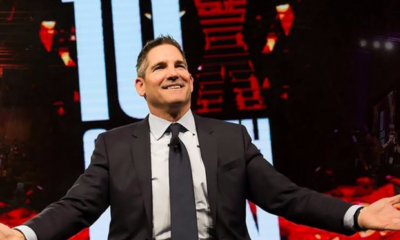Success Advice
The Real Reason Why Your Dreams Don’t Become a Reality According to ‘The 10x Rule’ by Grant Cardone

Everyone has dreams. We all want to make something of ourselves yet it’s only a tiny percentage of people ever follow through. The self-help world encourages us to “Think Big”, “Follow Your Passions”, “Live as if there was no such thing as failure” and it usually just leads to keeping people stuck in a dream state, wishing, hoping and fantasizing yet never actually moving forward.
Why is this? Thinking big is just one part of the equation. This missing piece in the jigsaw is a bias towards massive action. Big Dreams + Little Action = disappointment and frustration.
Thinking and dreaming big must match with the equal and equivalent amount of action for it to go anywhere. When you combine big thinking with massive action you will be surprised at how much you are capable of, once you tap into the power of momentum.
What stops most people from achieving their goals?
I’ve been reading Grant Cardone’s “The 10X Rule: The Only Difference Between Success and Failure” and in his view success comes from taking 10 times more action than you previously anticipated.
What stops most people from achieving a goal is underestimating the time, effort and energy involved in completing the project. They don’t spend enough time listing the steps required to succeed, the adversity they will need to overcome to push things through and the price they must pay to attain the goal.
If the number one sticking point in goal attainment is a lack of action then it’s obvious that the solution is in massive action. So what happens is they give up at the first sign of frustration or disappointment.
“Never reduce a target. Instead increase actions. When you start rethinking your targets, making up excuses, and letting yourself off the hook, you are giving up on your dreams.” – Grant Cardone
When I look back on my own life, anything I have ever achieved that was worthwhile did take an extraordinary amount of effort. Anytime I have ever coasted or done a “normal” amount of work, I would fall short of my target and feel the pain of frustration and disappointment which lead to reducing my targets.
In “The 10 X Rule” Cardone talks about his own failures in business and how he bounced back; “I committed to making this work by increasing my efforts 10 times. And as soon as I did that, everything started to change – immediately. I went back into the marketplace with the right estimation of effort and started seeing results. Instead of making two to three calls a day, I started doing 20 to 30”
Most people fail only because they are operating at the wrong degree of action. There are 4 degrees of action which you can choose from:
- Do Nothing
- Retreat
- Take Normal Levels of Action
- Take Massive Action
At the “do nothing” level people are just accepting what comes their way. They are not pushing themselves or motivated to improve any area of their lives.
Retreaters are those who have taken action, experienced some setbacks or failures and retreated back into “doing nothing”. Examples of this include “Most businesses fail anyway so I am going to give up”, “Marriages aren’t working out these days so I will stay single”, “Businesses aren’t employing so I am going to file for unemployment benefit”.
The third degree is normal levels of action which is usually considered adequate. Grant says this is the most dangerous level where most people blend in, never stand out and thus never achieve the real success they wanted.
Lastly there is massive action which Cardone states is our most natural state. This is where you burst forth with 10 times the action you previously anticipated. “The goal is to be seen, thought of and considered – in one way or another. Your only problem is obscurity not talent”.
Obscurity is your only problem not talent. I like that. I am sure you all know someone who is less capable than you but experiencing much more success than you are. Why? Because they are more known and fearlessly putting themselves “out there”. So which degree of action are you taking currently? And will you commit to taking 10x action?
“Regardless of which degree of action you operate in, they all require work in their own way.” – Grant Cardone
So why not set your goals and actions higher than you ever imagined because it is highly likely you are not only underestimating the time, energy and effort involved in your endeavour, you are also likely underestimating your own capabilities and potential. Set high goals and never stop fighting.
Share with us one goal you have for 2017, and how you plan on achieving it. Comment below so we can see!
Did You Know
How Skilled Migrants Are Building Successful Careers After Moving Countries
Behind every successful skilled migrant career is a mix of resilience, strategy, and navigating systems built for locals.

Moving to a new country for work is exciting, but it can also be unnerving. Skilled migrants leave behind familiar systems, networks, and support to pursue better job opportunities and a better future for their families. (more…)
Life
10 Research-Backed Steps to Create Real Change This New Year
This New Year could finally be the one where you break old patterns and create real, lasting change.

Every New Year, we make plans and set goals, but often repeat old patterns. (more…)
Change Your Mindset
The Silent Skill That Makes People Respect You Instantly
What truly earns respect and why most people go about it the wrong way

Everybody craves respect but not everyone earns it. Some people believe that a title, years of experience, or a position of authority automatically entitles them to respect. (more…)
Entrepreneurs
The Essential Skills Every Entrepreneur Needs In 2026
Success in the digital age isn’t about luck. It’s about mastering the skills that separate dreamers from doers.

When I was 22 years old, I started my first side hustle as a ghostwriter. (more…)
-

 Entrepreneurs4 weeks ago
Entrepreneurs4 weeks agoThe Essential Skills Every Entrepreneur Needs In 2026
-

 Change Your Mindset3 weeks ago
Change Your Mindset3 weeks agoHow to Turn Your Mind Into Your Greatest Asset (Instead of Your Enemy)
-

 Change Your Mindset3 weeks ago
Change Your Mindset3 weeks agoThe Silent Skill That Makes People Respect You Instantly
-

 Life2 weeks ago
Life2 weeks ago10 Research-Backed Steps to Create Real Change This New Year
-

 Tech2 weeks ago
Tech2 weeks agoWhat’s in a Name? How to Get Your Domain Right
-

 Did You Know2 weeks ago
Did You Know2 weeks agoHow Skilled Migrants Are Building Successful Careers After Moving Countries
























5 Comments